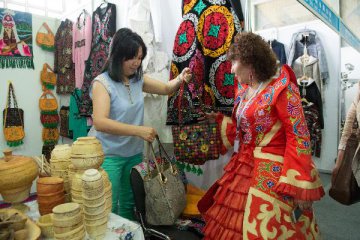URUMQI, Dec. 9 (Xinhua) -- Having grown up in the old town area of Kashgar, Xinjiang, Abdureshit is accustomed to having morning tea in a 100-year-old teahouse after finishing his prayers in the Id Kah Mosque at dawn.
On cold winter mornings, coppersmiths who get up early have begun to make pots or plates. Amid the tinkles and clangs, residents begin to wake up, have breakfast, sweep their courtyards and go to work.
Located in the downtown area of Kashgar, an ancient Silk Road city with a history of over 2,000 years, the old town is home to the world's largest earth architectural complex.
Labyrinthine, narrow lanes and crowded dwellings with elaborately carved doors and windows give a glimpse of the glory of the thriving old town along the Silk Road. Its exotic charm appeals to tourists from home and abroad.
The town becomes busier in the morning as tourists bustle around. Many visitors flock to the time-honored teahouse that Abdureshit always goes to, sipping on Uygurs' traditional herbal tea while appreciating the view of buildings and alleys from the second floor.
When it is too crowded, Abdureshit will move to a nearby small teahouse with his friends. The 72-year-old said he likes to make room for travelers.
"There's no need to be upset. On the contrary, I'm so proud that more people come to visit and are falling in love with my hometown," Abdureshit said.
There are performances of local songs and dances at around 10 a.m. Tourists can enjoy the shows, go shopping in various shops or just walk around to explore the traces of different cultures, ethnic groups and religions.
Mewlan Turaq, 26, is an owner of a vintage clothing shop. He displays over a dozen articles of Uygur clothing in his shop, showing the changes in traditional Uygur clothing over the past century.
The clothing is very popular among tourists, along with other products such as vintage accessories, mobile phone cases and bags with Uygur characteristics. Many travelers try on the clothing and pay for camera crews to take photos of them in the old town.
"Since more and more tourists are traveling to Kashgar, the previous 10-square-meter shop was too small. So I moved into the new shop, which is 30 square meters. My mum now runs the smaller one," the young man said.
Salametgul Khari was the first person in the old town who opened her home to tourists two years ago, allowing strangers to enter her home, eat, sing and dance with her family at a reasonable price. This innovative method offered out-of-towners a fresh experience to immerse themselves into the true life of Uygurs. Salametgul's success caused many locals to follow suit.
"We served more tourists this summer than the last. The number of chefs and waiters I employ this year has increased to 18. Many tourists said they want to stay for several days, so I traveled to Yunnan and Sichuan provinces to learn homestay operation. I plan to open 10 rooms for homestay next year," she said.
When night falls, the old town transforms. Unlike the leisureliness during the day, the old town is illumined by the bustling night bazaar. The mouthwatering aroma of roasted lamb, fried lamb sweetbread and beef attract both tourists and local residents.
Abdukerim Memet has run a small booth selling zongzi in the bazaar for more than four decades.
Zongzi, or sticky rice dumpling, is a traditional food during the celebration of the Dragon Boat Festival. It is made of glutinous rice with fillings wrapped in bamboo leaves.
Although Abdukerim does not know the origin of the snack, he knows the elders started to sell zongzi at the bazaar long ago. The old man uses local reed leaves instead of bamboo leaves to wrap the rice, which he said comes from east China's Fujian Province. He also pours yogurt on zongzi instead of sugar. With an increasing number of tourists, he can earn about 600 yuan (85 U.S. dollars) per night.
Statistics showed, from January to October, Kashgar received over 14 million tourists from all over the world, up 63 percent year on year.
Today, a comfortable life and tourism boom in the old town is ascribed to a huge renovation project in Kashgar.
There were over 200,000 residents squeezed in the eight-square-kilometer old town. Crowded old buildings were under risk of fire hazards and house collapse, and there was a lack of conditions for developing tourism.
In 2010, the Chinese government kicked off an renovation project in the old town of Kashgar with an investment of more than 7 billion yuan, rendering local buildings earthquake-proof while maintaining their traditional Uygur charm.
Nearly 50,000 households had their old and dilapidated houses renovated due to the project. Modern infrastructure and facilities have made the lives of local residents easier and cozier, and facilitated the development of tourism.





















Latest comments